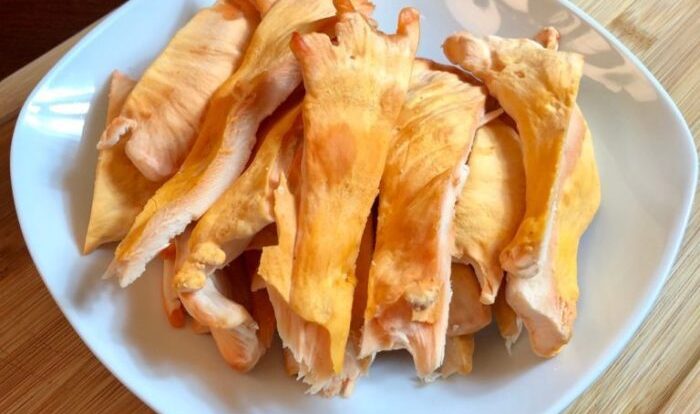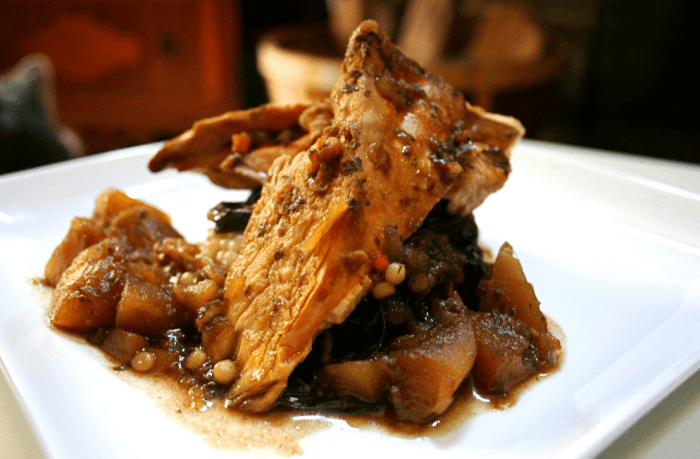
Chicken of the woods recipe – Embark on a culinary adventure with the enigmatic Chicken of the Woods, a vibrant mushroom that captivates taste buds and sparks curiosity.
From its vibrant hues to its versatility in the kitchen, Chicken of the Woods is a true culinary gem. Join us as we delve into the fascinating world of this woodland delicacy, exploring its flavors, health benefits, and the secrets of responsible foraging.
Introduction to Chicken of the Woods

Chicken of the Woods, also known as Laetiporus sulphureus, is a remarkable fungus that has captivated foragers and culinary enthusiasts alike. This unique mushroom stands out with its vibrant orange or yellow coloration and its distinctive, chicken-like texture when cooked.
Chicken of the Woods is not only a culinary delight but also a nutritional powerhouse, boasting an impressive array of vitamins, minerals, and antioxidants.
Nutritional Value
- Rich in Vitamins:Chicken of the Woods is a great source of vitamins B1, B2, B3, and vitamin C, which are essential for various bodily functions, including energy production, metabolism, and immune support.
- Packed with Minerals:It contains a diverse range of minerals, including potassium, phosphorus, iron, and zinc, which play crucial roles in maintaining electrolyte balance, bone health, and oxygen transport.
- Antioxidant Properties:Chicken of the Woods is rich in antioxidants, such as ergothioneine and glutathione, which help protect cells from damage caused by free radicals, reducing the risk of chronic diseases.
Foraging and Identification
Foraging for Chicken of the Woods is a rewarding experience, but it’s crucial to approach it responsibly. Here are some guidelines to help you find and identify this delectable fungus.
Habitat and Identification
- Chicken of the Woods typically grows on dead or decaying hardwood trees, especially oak, maple, and beech.
- Look for shelf-like structures with bright orange or yellow undersides.
- The flesh should be firm and white, and the edges should be wavy or lobed.
Distinguishing from Lookalikes, Chicken of the woods recipe
There are a few similar-looking mushrooms that can be mistaken for Chicken of the Woods. Here’s how to tell them apart:
- Laetiporus sulphureus: This false chicken has a duller orange color and a more rigid texture.
- Polyporus squamosus: Also known as Dryad’s Saddle, this mushroom has a scaly or shaggy cap and a more fibrous texture.
- Ganoderma tsugae: This hemlock varnish shelf has a hard, glossy cap and a bitter taste.
Responsible Foraging
Remember, foraging is a privilege. Always follow these responsible practices:
- Only harvest what you need and leave plenty for others and wildlife.
- Avoid picking mushrooms in heavily trafficked areas or near pollution sources.
- If you’re unsure about a mushroom’s identity, leave it alone.
Culinary Applications: Chicken Of The Woods Recipe

Chicken of the Woods is a versatile culinary mushroom that can be cooked in various ways to bring out its unique flavor and texture. Its meaty texture and mild, slightly sweet taste make it a popular choice for vegetarians and meat-eaters alike.
Cooking Methods
- Sautéing:Sautéing is a quick and easy way to cook Chicken of the Woods. Simply heat some oil in a pan and add the mushrooms. Cook until they are browned and tender, about 5-7 minutes.
- Grilling:Grilling is another great way to cook Chicken of the Woods. Preheat your grill to medium-high heat and brush the mushrooms with olive oil. Grill for 5-7 minutes per side, or until they are cooked through.
- Roasting:Roasting is a good way to cook Chicken of the Woods if you want to bring out their full flavor. Preheat your oven to 400 degrees Fahrenheit (200 degrees Celsius) and toss the mushrooms with olive oil, salt, and pepper.
Roast for 15-20 minutes, or until they are browned and tender.
Flavor Profile and Texture
Chicken of the Woods has a mild, slightly sweet flavor that is similar to chicken. It has a meaty texture that is slightly chewy when cooked. The flavor of Chicken of the Woods can vary depending on the type of tree it is growing on.
For those looking for a more detailed guide, the chicken of the woods recipe provided by the Marion County Extension Service is a great resource. This recipe includes step-by-step instructions, as well as tips for harvesting and cleaning the chicken of the woods.
With its easy-to-follow instructions and helpful advice, this recipe will help you make the most of this unique and flavorful mushroom.
Mushrooms that grow on oak trees tend to have a more robust flavor than those that grow on other trees.
Health Benefits and Medicinal Uses

Chicken of the Woods boasts an impressive array of health benefits, thanks to its rich antioxidant and anti-inflammatory properties.
In traditional medicine, it has been used for centuries to treat various ailments, including digestive issues, skin infections, and inflammation.
Antioxidant Properties
- Chicken of the Woods is a potent source of antioxidants, which help protect cells from damage caused by free radicals.
- These antioxidants may reduce the risk of chronic diseases, such as heart disease, cancer, and Alzheimer’s.
Anti-inflammatory Properties
- The anti-inflammatory compounds in Chicken of the Woods may help alleviate inflammation throughout the body.
- This can be beneficial for conditions such as arthritis, asthma, and inflammatory bowel disease.
Traditional Medicinal Uses
- In traditional Chinese medicine, Chicken of the Woods is believed to strengthen the immune system and improve digestion.
- In Ayurvedic medicine, it is used to treat skin infections, ulcers, and inflammation.
Risks and Precautions
- Chicken of the Woods is generally safe to consume, but some people may experience allergic reactions.
- It is important to cook Chicken of the Woods thoroughly before eating, as raw mushrooms can contain toxins.
Storage and Preservation
Maintaining the freshness of Chicken of the Woods is crucial to enjoy its culinary and medicinal benefits. Proper storage and preservation techniques help extend its shelf life and prevent spoilage, ensuring optimal quality and safety.
Storing Fresh Chicken of the Woods
- Refrigeration: Fresh Chicken of the Woods can be stored in the refrigerator for up to 5-7 days. Wrap it loosely in a paper towel or place it in a breathable container to maintain moisture while allowing air circulation.
- Freezing: For longer storage, freezing is an effective option. Cut the Chicken of the Woods into smaller pieces, blanch them briefly, and then freeze them in airtight containers. Frozen Chicken of the Woods can last for several months.
Preserving Chicken of the Woods
- Drying: Drying is a traditional method of preserving Chicken of the Woods. Slice the mushroom thinly and dehydrate it in a food dehydrator or oven until it becomes crispy. Dried Chicken of the Woods can be stored in airtight containers for several months.
If you’re a fan of wild edibles, you’ll want to check out the chicken of the woods recipe . This fungus, known for its vibrant orange color and chicken-like texture, is a delicious and nutritious treat that can be found in forests across the globe.
Whether you’re sautéing it with butter or grilling it with vegetables, the chicken of the woods recipe is sure to impress.
- Freezing: As mentioned earlier, freezing is a great way to preserve Chicken of the Woods. Blanching the mushrooms before freezing helps retain their texture and flavor.
- Pickling: Pickling is another option for preserving Chicken of the Woods. Create a pickling brine using vinegar, water, salt, and spices, and submerge the mushrooms in the solution. Pickled Chicken of the Woods can be stored in the refrigerator for several months.
Final Conclusion
As we bid farewell to the world of Chicken of the Woods, let us remember its culinary versatility, medicinal properties, and the importance of responsible foraging. Whether sautéed, grilled, or roasted, this extraordinary mushroom leaves an unforgettable mark on our palates and our well-being.
May our journey through the realm of Chicken of the Woods inspire you to explore the hidden treasures of the natural world and embrace the joy of sustainable foraging.
Question & Answer Hub
Is Chicken of the Woods safe to eat?
Yes, Chicken of the Woods is generally considered safe to eat when properly identified and cooked. However, it’s important to consult with a qualified expert or use reliable identification resources before consuming any wild mushrooms.
What does Chicken of the Woods taste like?
Chicken of the Woods has a mild, slightly sweet flavor that is often described as resembling chicken or seafood. Its texture is firm and slightly chewy when cooked.
How can I store Chicken of the Woods?
Fresh Chicken of the Woods should be stored in the refrigerator for up to 5 days. It can also be dried, frozen, or pickled for longer-term storage.






